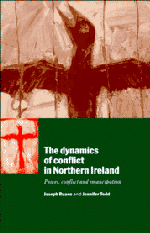Book contents
- Frontmatter
- Contents
- List of figures
- List of tables
- Preface
- 1 Introduction
- 2 Historical formations
- 3 The reconstruction of communal division
- 4 Ideology and conflict
- 5 The dynamics of conflict: politics
- 6 The dynamics of conflict: the economy
- 7 The dynamics of conflict: culture
- 8 The British context of the Northern Ireland conflict
- 9 The Republic of Ireland and the conflict in Northern Ireland
- 10 The international context
- 11 An emancipatory approach to the conflict
- Epilogue
- Appendix
- Bibliography
- Index of names
- Index of subjects
7 - The dynamics of conflict: culture
Published online by Cambridge University Press: 18 December 2009
- Frontmatter
- Contents
- List of figures
- List of tables
- Preface
- 1 Introduction
- 2 Historical formations
- 3 The reconstruction of communal division
- 4 Ideology and conflict
- 5 The dynamics of conflict: politics
- 6 The dynamics of conflict: the economy
- 7 The dynamics of conflict: culture
- 8 The British context of the Northern Ireland conflict
- 9 The Republic of Ireland and the conflict in Northern Ireland
- 10 The international context
- 11 An emancipatory approach to the conflict
- Epilogue
- Appendix
- Bibliography
- Index of names
- Index of subjects
Summary
Culture – identity, values, norms, ethos, world view, sense of place in history and in the world – provides another arena for conflict in Northern Ireland. Conflict has centred on the ways in which cultural differences between the communities have been inscribed in public relations of hierarchy and control. It is fought out in the symbolic practices of the public sphere and in the meanings embodied in the state and public institutions. In this chapter we trace the development of cultural conflict, assess the communities' relative cultural status and power and the meanings of cultural conflict today.
The making of Protestant cultural dominance
English control in Ireland in the sixteenth and seventeenth centuries was secured culturally as well as militarily and politically. The Protestant religion, the English language and English notions of civility and order were to be dominant in Ireland, ideally accepted by the majority of the people but at the very least the culture of the economic and political power-holders. English – and to a lesser extent Scottish – settlers were to be the agents of this acculturating process and they became the embodiment of English/British culture in Ireland. This process took a distinctive form in Ulster. There the clash between settler and native cultures was particularly sharp and the extent of native displacement greatest. A culturally complex social world emerged. English influence was predominant among the aristocracy and gentry throughout Ulster; Scottish influence was strong among the middle classes, particularly in the east. Gaelic-Irish culture and its successor hybrid culture (chapter 2) remained important at the lower social levels, in the remoter areas and on Ulster's borders.
- Type
- Chapter
- Information
- The Dynamics of Conflict in Northern IrelandPower, Conflict and Emancipation, pp. 178 - 203Publisher: Cambridge University PressPrint publication year: 1996



